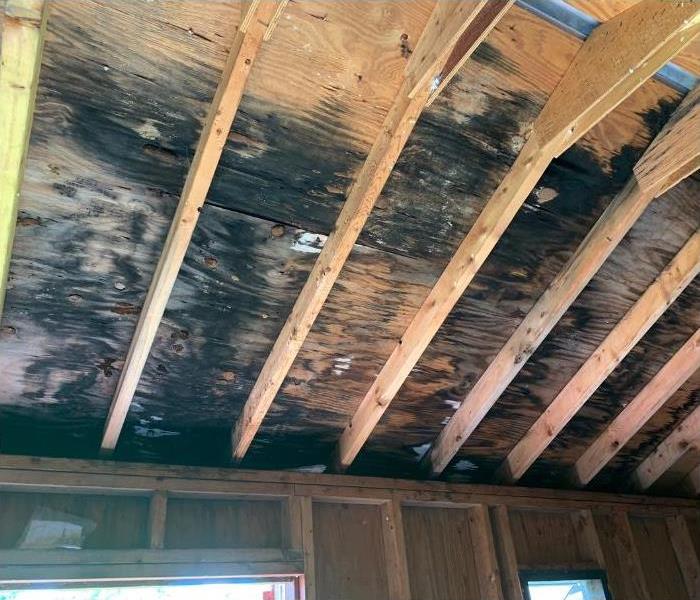Mold Damage Restoration: How Hidden Leaking Pipes Can Affect Your Home in Sandy, UT
9/20/2024 (Permalink)
When it comes to home maintenance, a hidden leaking pipe can be a homeowner's worst nightmare. In Sandy, UT, where the climate can exacerbate water damage issues, understanding how these hidden leaks can lead to severe mold problems is crucial. Mold damage restoration requires a comprehensive approach, especially when the source of the moisture is elusive. Here’s what you need to know about dealing with mold damage caused by hidden leaking pipes and how to handle the restoration process effectively.
The Hidden Threat: How Leaking Pipes Cause Mold Growth
Many homeowners in Sandy may not realize that their pipes are leaking until it's too late. A hidden leak—often in walls, ceilings, or floors—can go unnoticed for a long time. These leaks provide a constant source of moisture, which is a key ingredient for mold growth. Mold spores, which are present in the air everywhere, can settle on damp surfaces and start growing rapidly.
The conditions created by a hidden leak are ideal for mold proliferation. Mold needs three things to thrive:
Moisture: The ongoing leak provides a consistent supply of water.
Temperature: Most mold grows best in temperatures between 60-80°F.
Organic Material: Building materials like wood, drywall, and insulation are perfect food sources for mold.
When a leak occurs behind walls or under floors, it can be difficult to detect until the mold has already started to spread. By the time visible signs appear—such as discoloration or a musty smell—the mold problem may be extensive and challenging to address.
Identifying the Signs of Mold Damage
Detecting mold damage early can prevent extensive repair work and health risks. Here are some common signs that indicate a hidden leak might be causing mold damage in your Sandy home:
Musty Odors: A persistent musty smell, even if you can’t see any mold, is often an early warning sign.
Discolored Walls or Ceilings: Yellow, brown, or black spots on walls or ceilings can indicate mold growth behind surfaces.
Peeling Paint or Wallpaper: Water damage often causes paint or wallpaper to peel away.
Warped or Sagging Floors: Moisture from a leak can cause flooring to buckle or sag.
Increased Allergies: Unexplained allergy symptoms or respiratory issues can be a sign of mold exposure.
If you notice any of these signs, it’s essential to act quickly. The longer you wait, the more extensive the damage can become.
Steps to Address Mold Damage from Hidden Leaking Pipes
Locate the Source of the Leak:
The first step in mold damage restoration is finding and fixing the source of the leak. This often requires professional assistance, as leaks behind walls or under floors can be challenging to pinpoint. A plumber or a water damage specialist can use specialized tools like moisture meters and thermal imaging cameras to locate the source.
Fix the Leak:
Once the source is identified, it must be repaired immediately. This might involve replacing damaged pipes, sealing leaks, or performing other necessary plumbing repairs. Addressing the leak promptly helps prevent further water damage and mold growth.
Remove Affected Materials:
After fixing the leak, the next step is to remove and dispose of any materials that have been severely damaged by water and mold. This might include drywall, insulation, or flooring. In cases where the mold infestation is severe, it’s crucial to use protective gear and follow proper procedures to avoid spreading spores.
Clean and Dry the Area:
Thoroughly clean the affected area using specialized cleaning agents designed to kill mold spores. Dry the area completely using dehumidifiers and fans. Mold thrives in damp environments, so ensuring that the area is dry is essential for preventing future growth.
Treat the Mold:
For areas with visible mold, professional mold remediation services are often required. Mold remediation involves more than just cleaning; it includes treating surfaces with antifungal solutions to kill mold spores and prevent future growth. In some cases, professional services may be necessary to ensure that all mold is effectively removed.
Repair and Restore:
Once the mold has been removed and the area is dry, you can begin repairs. This involves replacing damaged materials such as drywall, insulation, and flooring. Ensure that any repairs are done to prevent future leaks and moisture issues.
Preventing Future Mold Damage
To prevent future mold issues caused by hidden leaks, consider these proactive measures:
Regular Inspections:
Conduct regular inspections of your plumbing system to identify any potential issues before they become major problems. Pay attention to areas that are prone to leaks, such as under sinks and around appliances.
Maintain Proper Ventilation:
Ensure that your home is well-ventilated to reduce humidity levels. Use exhaust fans in areas like bathrooms and kitchens, and consider using a dehumidifier if you live in a particularly humid area.
Address Water Damage Immediately:
If you experience any form of water damage, address it immediately. Quick action can prevent minor issues from becoming major problems.
Insulate Pipes:
Properly insulate pipes to prevent freezing and potential leaks, especially in colder months.
Mold damage restoration in Sandy, UT, starts with addressing the root cause of the problem—hidden leaking pipes. By understanding the risks and signs of mold damage, you can take proactive steps to protect your home and ensure a thorough restoration process. If you suspect mold damage, don’t hesitate to seek professional help to address the issue effectively and prevent future problems. Remember, timely intervention is key to maintaining a safe and healthy home environment.




 24/7 Emergency Service
24/7 Emergency Service
